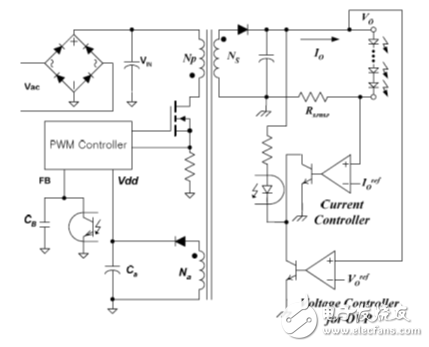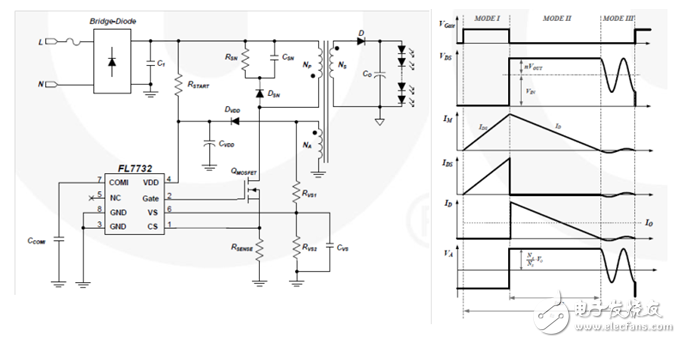The consumer electronics market (especially the LED-driven market) has grown rapidly in recent years. These markets require power/drivers that are low power, small in size, and extremely low cost. In addition, the use of power factor correction (PFC) circuits on these devices is almost essential as power quality requirements continue to increase. Today, in many different circuits, flyback is the most attractive topology for these applications because of its simplicity. It uses a switch to provide insulation, startup, and various other protections. When operating in discontinuous conduction mode, the power factor is 1 by a simple constant on-time control.
Traditionally, constant current LED driving for LEDs has been implemented using an isolated flyback converter with an output current regulation circuit as shown in FIG. The actual LED current is measured using a sense resistor and then compared to a reference voltage to generate an error voltage. The error voltage is transmitted to the primary side through the photocoupler and is used to control the duty cycle of the primary side switching device. While this enables superior LED current regulation, the output regulation circuit requires the use of optocouplers, reference voltages, and sense resistors to increase system cost and reduce overall efficiency.

Figure 1 Traditional secondary side regulated LED driver
Primary Side Regulation (PSR) can be the best solution to minimize LED drive costs. This technology uses only the information on the primary side of the driver to precisely control the LED current at the secondary side. It not only eliminates output current sensing losses, but also reduces all secondary feedback circuits. This facilitates a more efficient off-line LED driver design without significant cost. This technology can adjust the LED driver output voltage without a secondary feedback circuit, and can be used for open-circuit over-voltage protection to ensure better reliability of the driver.

Figure 2 primary side adjustment LED driver and its typical waveform
Figure 2 shows a simplified circuit diagram of a primary-side regulated flyback converter and its typical operating waveform. The key to primary side regulation is to obtain output voltage and current information without the need for direct sensing.
During the diode on-time, the sum of the output voltage and the forward voltage drop of the diode is reflected to the auxiliary winding as (VO+VF)*Na/Ns. Output voltage information can be obtained by sampling the winding voltage at the end of the diode conduction time. The output current (Io) can be estimated using the peak drain current (Ipk) of the MOSFET and the discharge time (tDIS) of the inductor current, since the output current (Io) is the same as the average of the diode current (ID) at steady state. The output current is estimated by the peak detection circuit to determine the peak value of the drain current, and the inductor discharge time and switching period (ts) are used to calculate the output current. This output is compared to an internal precision reference voltage to produce an error voltage (VCOMI) that determines the duty cycle of the MOSFET. Use Fairchild's innovative TRUECURRENT® technology to precisely control constant output current.

Using the detected output voltage and current information, control can be accomplished by conventional feedback compensation methods. For primary side regulation, discontinuous conduction mode (DCM) operation is often preferred. It has better output regulation and unit input power factor (PF).
——This article is selected from the electronic enthusiast website May “Green Lighting Technology Special Issue†to see the new design column, please indicate the source!
For Samsung Oca,Samsung Galaxy S23 Oca Sheet,5 Inch Oca Glue Sheet,Oca Glue For Sansung
Dongguan Jili Electronic Technology Co., Ltd. , https://www.ocasheet.com